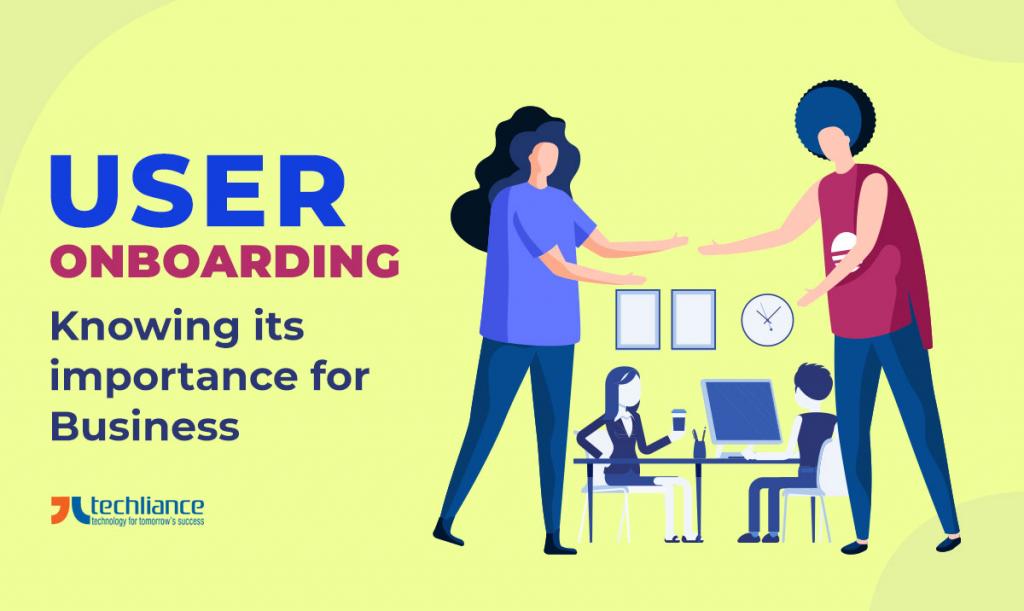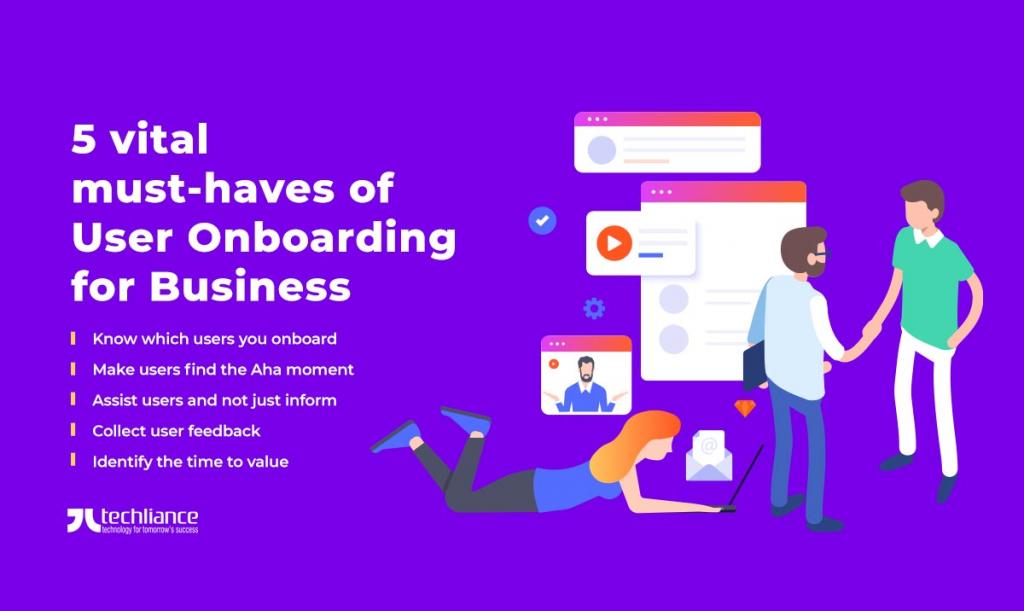Everybody struggles to use a product for the first time. Businesses globally and in the USA must communicate the value of their products or services to the users during 2024. This is where user onboarding comes in handy for large corporations, small enterprises, and startups.
Users want to know the purpose behind your mobile app, website, or digital solution. What kind of problem is your product or service solving? Getting aware of the chief aim of onboarding users helps a lot here.
In this article, we will find out the five must-haves for you to successfully onboard users. First-of-all, we need to know what user onboarding means. Also, we try to grasp the main goal of onboarding a user.

What is user onboarding? What’s the goal of onboarding users?
User onboarding guides end-users in discovering value from your product or service. While it may get complex, it is crucial for the success of your business. Because everyone seeks assistance to know more about how to use a product/service.
Many people think that the objective of user onboarding is to make them experts at using your product or service. However, its actual goal is to make your product/service in enabling people to become better at what they do. For example, here are a few applications that enhance productivity greatly.
- Adobe Photoshop is for helping graphic designers get better at creating graphics.
- Slack is for enhancing internal communication with your team.
- Appcues helps you analyze product usage, empowering you to effectively analyze product adoption and usage over time.

5 vital must-haves of User Onboarding for Business
Here are the best practices that play part in successful user onboarding for businesses in 2024.
- Know which users you onboard
- Make users find the Aha moment
- Assist users and not just inform
- Collect user feedback
- Identify the time to value
Next, we briefly discuss these tactics that can streamline your user onboarding drive.
Know which users you onboard
Users are human beings, which means that they are not all the same. Even though you will have people downloading and using your product, it is essential to know who is using it. This is very necessary when defining the users’ onboarding experience worldwide and in the United States.
Learn in the early stages who will use your product by creating user personas. It is the best time to ask yourself how a specific feature of your product will help the user. Never forget that users invest time in your product.
The time users spend on your product directly impacts the success of your investment. For instance, you are selling software or a custom solution. Your main goal is to research who is downloading and using your product.
Are they business owners, common users, software developers, marketers, SEO specialists, or who? Play well with the data of the user downloads. This gives you better information on how you can give your users the proper onboarding.
Now, it is time to research and find out who is using your product. Without taking this step, you can’t move to the next one. So, when you are done designing your product’s features, it is time to start doing some in-depth research.
Make users find the Aha moment
The “aha” moment is when your user discovers how your product works. This is usually the phase where users turn into customers. The aha moment plays a vital role in increasing retention and growing revenue.
This moment doesn’t happen when you give your users an extensive manual to read about your product or service. Instead, it occurs when they understand its benefits with little hassle. For example, you have SaaS software for internal communication.
A triumphant aha moment in your software would be like this.
- The users download the software.
- They use the software for communicating with their team.
- Internal communication includes sharing tasks and information without exposing it to anyone except the team.
- The users see that this software is helpful for them and find the aha moment in it.
- Subsequently, the users subscribe to your paid plan or buy the software (depending on how you sell).
Remember that Slack is a SaaS software that people use for internal communication. Initially, those users who used it found out how valuable it is. They saw that they wouldn’t work as efficiently without this software.
What is so special about using Slack? Users find out that it isn’t like Facebook or Instagram, where you expose yourself personally. Slack adopters realize the software as a professional one, so this is the aha moment in it.
Moreover, Slack is free to download and use. But, the free plan limits users from utilizing crucial features. For instance, after you surpass 10,000 messages, older messages get deleted.

Assist users and not just inform
The worst thing you do to users is to provide long textual information for understanding the usage of your product. Nobody likes to read lengthy and complex texts, let’s be honest about this. So, most users will just give up and avoid learning about your product.
Interacting with your users and even setting up visual or video guidelines is the best way. It will assist them in easily learning about your product or service. This method is more successful than leaving them to try and learn it all by themselves.
Realize that user onboarding doesn’t work that way. Let’s suppose you desire to take your users through a product tour. So, you should assist them through interactive guides regarding a particular product or service feature.
Just in case, you use this collaborative method of interaction. Then, the users will be able to easily remember how and what to do with your product or service. This aids your adopters big time in their user onboarding journey.
Collect user feedback
If you want to have successful user onboarding, gathering user feedback is the key. Feedback helps you enhance product adoption, increase user retention, and enhance user experience. Even, it allows you to learn where you have weaknesses within your product or service.
After receiving feedback, you know what users like and dislike about your product or service. For successfully collecting feedback, ask your users just a few questions. Inquire users about what you can improve in your product or service.
Avoid asking too many questions. As it may seem to complicate your users to a point where they won’t answer any of your questions. Bear in mind to keep it short and simple.
Have you seen how Zoom or Google meet ask you to rate their services after you have a call? Well, that is precisely what you must aim for. After all, more is not always the best in user communications through 2024.
Join hands: Let us craft an App or smart solution that onboards users to your business
Identify the time to value
One essential onboarding term to know about is time to value (TTV). In short, TTV is the overall time it takes a new user to receive value from your product or service. TTV is comparable to ROI (return on investment).
ROI calculates the success of any financial spending. On the other hand, TTV measures the effectiveness of an investment. Each product or service has a different TTV.
Issues that arise with time to value are the amount of patience a customer may have. Sadly, most customers don’t have patience in this fast age. So, the longer you take to complete user onboarding, the more likely customers will run away from your product/service.
40% of customers indicate they’ll pay extra if they get the desired product/service value within the same day. The only thing you can do about this is to reduce the time to value as much as you can. The shorter the TTV is, the better it is.
Types of TTV
For some users, TTV happens earlier; while for others, TTV may come much later. There are many types of TTV. We have a look at two primary kinds of TTV.
Immediate or Short TTV: The product’s value is recognizable as soon as it is put to use. For instance, SEMrush is an SEO software that helps you find keywords for your website, blog, article, and more. All you need to do is type in a relevant term. SEMrush will provide you with the most suitable keywords for your niche and competitiveness. In this case, you are getting an immediate TTV.
Long TTV: The long-term TTV is most common in software (usually Saas products). Only using the software product isn’t enough to find its value, but it takes time in this case. For example, signing up for software that shows you your business analytics won’t give you the value from day one. Analytics can be shown after a specific time, such as after a week. Likewise, information will become actionable after a few months of usage.

Wrapping it up
Utilize our five essential tips for improving the user onboarding experience of your customers. Hopefully, you read the article carefully and learn a thing or two from it. Thus, you will realize that user onboarding isn’t really about making your product or service complex to use.
Rather, user onboarding is about assisting your customers and shortening their time to value. Read through each section wisely and see how you can implement it in your user onboarding procedure. Avoid getting complex, assist your users with any uncertainties, and never disregard collecting feedback.
Do you want to create a digital solution that is effective to onboard users? Techliance covers you right from ideation to deployment. We can develop a high-performing application that provides a successful user onboarding journey.




